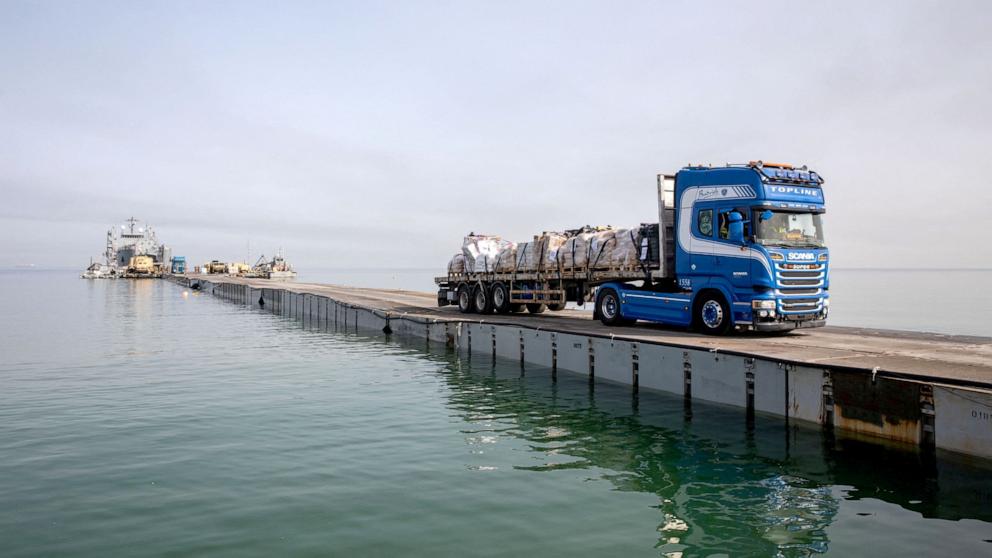World
US military pier to deliver humanitarian aid repaired, reconnected to Gaza beach

Food and other supplies should flow “in the coming days,” an official said.
After being out of commission for almost two weeks, the U.S. military’s temporary pier has been repaired and was reattached to a beach in Gaza on Friday morning with humanitarian aid deliveries expected to resume “in the coming days,” said a top U.S. military official.
The Joint Logistics Over the Shore (JLOTS) system had operated for little more than a week before high seas damaged the pier forcing extensive repairs that ended the U.S. goal of providing an additional route for food and humanitarian aid into Gaza.
“I’m very pleased to announce that earlier this morning in Gaza, U.S. forces successfully attached the temporary pier to the Gaza beach,” Vice Admiral Brad Cooper, the deputy of U.S. Central Command, told reporters on Friday.
The specific part of the pier that broke off from the causeway, anchored to the beach, is the larger platform where small Army vessels unloaded the trucks that would be driven onto it. The trucks would then head toward a marshaling area where aid is transferred to other trucks for distribution inside Gaza by the United Nation’s World Food Program.
“The policy of no U.S. boots on the ground does remain in effect. We expect to resume delivery of humanitarian assistance from the sea in the coming days,” he added.
The reattachment to the beach was done by Israel Defense Forces engineers, just as was done the first time when the pier went into operation in mid-May.
But a week later, on May 25, the pier suffered major damage from high waves due to a storm system north of Africa. The pier was then towed to the port of Ashdod, Israel, where it took more than a week to rebuild the damaged portions.
During its one week of operations, 1,000 metric tons of aid equal to more than 2 million pounds came into Gaza via JLOTS accounting for about 30% of all aid delivered to Gaza that week.
With the resumption of operations, JLOTS will become the third route for aid into Gaza at a time when low amounts of aid are arriving into Gaza via the other two land routes.
“Given its proven success, we expect to increase the volume of humanitarian assistance provided through the pier over the previous levels,” said Cooper. “We anticipate that our goal will be to deliver 500,000 pounds over the beach initially and then ramp that up soon thereafter. So, essentially, essentially every day a million pounds over every two-day period.”
Aid will begin flowing shortly but for now conditions are being evaluated to make sure that weather conditions are appropriate and everything is working properly before aid deliveries are resumed.
Cooper said that “thousands of pounds of aid” will be moved over the pier in coming days. While the JLOTS system was down and being repaired, food deliveries to U.S. ships offshore continued enabling the delivery via JLOTS once it was repaired and reattached.
And given that weather conditions have already impacted operations Cooper said that contingency plans are in effect should weather once again become an issue.
Prior to JLOTS arrival, the U.S. military had conducted air drops of food and humanitarian aid into Gaza but Cooper said those operations ceased because of new fighting in northern areas of Gaza.
“We do expect those to resume here in the coming days,” he said.
A service member who was injured during JLOTS operations in late May remains in critical condition and has been transferred to the Brooke Army Medical Center in Texas, an official said.
The JLOTS pier system is expected to come in nearly $100 million under its initial $320 million estimated operating cost, the Pentagon said Thursday.
“Lower than expected costs for contracted truck drivers and commercial vessels, and the United Kingdom’s contribution of a birthing vessel for our soldiers and sailors, have lowered our latest cost assessment to approximately $230 million,” Pentagon deputy press secretary Sabrina Singh told reporters Thursday.
She added that the lower figure will take into account the costs of repairing the pier.







:max_bytes(150000):strip_icc()/roundup-writereditor-loved-deals-tout-f5de51f85de145b2b1eb99cdb7b6cb84.jpg)


